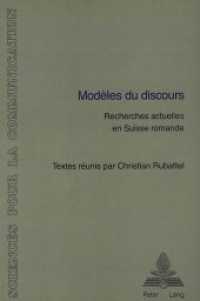- ホーム
- > 洋書
- > ドイツ書
- > Mathematics, Sciences & Technology
- > Technology
- > construction & environment engineering
基本説明
Handbook for the design of solar assisted airconditioning systems.
Full Description
This second edition of a hugely important work on this subject still plugs a gap in the literature. It is a source of crucial support to the planner in the design of solar assisted air-conditioning systems, which use solar collectors as a heat source. Air conditioning contributes significantly to the energy consumption of buildings in many countries and a promising possibility for energy reduction is the use of solar thermal energy in solar-assisted air conditioning systems. However, until today only a few systems have been installed world-wide and design and operation experiences are fairly poor.
Contents
Editor's notes.- Authors, contributors.- Introduction.- COMPONENTS: The load sub-system -- air-conditioning equipment: All-air systems; Water systems; Air-water systems.- The cold production sub-system: Chillers; Desiccant cooling systems; Other components of air-conditioning systems.- The heat production sub-system: Solar collectors and back-up heat source; Storage systems.- SYSTEMS: System configurations: examples, control and operation: Solar-assisted and solar thermally autonomous systems; Characterisation of solar-thermally driven cooling systems.- Design approaches: Rules of thumb; Comparison of solar collectors; Gross heat production of the collector; Correlation between solar gains and cooling (heating) loads; SACE method; TASK 25 design tool; Simulation programs.- Performance figures: Energy performance; Economic performance; Environmental benefits.- Design examples: The SARANTIS cosmetics factory at Inofita Viotias, Greece; An office building in Guadeloupe; The IHK desiccant cooling system in Freiburg, Germany.- Summary.- References.- Appendices: Example load parameters; Performance example parameters; The IEA Solar Heating & Cooling Programme; Task 25 Solar-Assisted Air-Conditioning of Buildings








